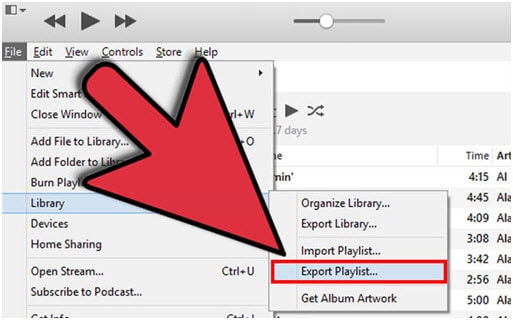
- #Itunes playlist export xml how to#
- #Itunes playlist export xml full#
- #Itunes playlist export xml software#
The script runs once per hour (timer controlled) and can also be called manually via File | Create Reports | Tracks and Playlists (iTunes library.xml). the first import in SqueezeCenter took about 9 minutes.Just for kicks a few stats (based on a C2Q 3.0GHz, 4 GB RAM system): That works fairly well and as I intended to I can import that xml from within SqueezeCenter again. So I made a script that exports the database (songs and playlists) into iTunes' library.xml. I have toyed with the idea of generating an XML file to be put in the same location as the tracks - MM3 will manage the moving of it and the data could be easily got at via scripting.Īlthough it will be reinventing the wheel as it were, I will be investigating further once I have finished playing with my touch.
#Itunes playlist export xml full#
If your are still using your iTunes library then the good news is that the XML file is updated in real-time, the bad is that MM hasn't the flexibility/fields to make full use of the data.
#Itunes playlist export xml how to#
I have yet to work out how to generate the link to all the external (local) artwork - store purchases are easy, the others may be more of a curiosity as you only get lower quality versions (which can be got at via other means). you need to piece it back together from three separate sources (four if you want the best quality artwork).Īs it is a property list, it is really more of an ini file than a true XML structure, so significant performance gains can be had by preprocessing it with either Regular Expressions or XSLT - especially so for large libraries. The XML file doesn't give you all the details - Apple isn't going to make it so easy. c) surely is more efficient.ĮDIT: please see below for a script which implements approach B. I guess b) is the most versatile way and arguably also the easiest way. Since SqueezeCenter uses a MySQL database there is probably another option,Ĭ) copy data directly from MM db to SC db. Apparently I have two choices to make SqueezeCenter work with the MM data:Ī) learn Perl and create a SqueezeCenter plugin for MM orī) misuse the existing SqueezeCenter iTunes plugin which reads the library.xml file.
#Itunes playlist export xml software#
In this case it is Logitech's SqueezeCenter which is a Perl based server software for the Squeezebox family of audio streaming devices. As with the other requests I want to use a program which can interface with the iTunes library.xml file but no the MM database. Has there been some work as to exporting a snapshot of the MM database to an iTunes library.xml file? I searched the forums and found a few requests about this but nothing substantial. You can force the iTunes Library tags to be written out to MP3 files (this won't help you now, but if you had the original library you could do this, then import the songs into the new library before importing the playlists and you would get little to no errors).ADDON IS UPDATED TO WORK WITH LATEST VERSION OF MMW AND OTHER APPS.

The changes stay until the MP3 is played again.this has been this way for over 10 years. Once you play the MP3 file the tags in the library is updated to show the ID3 tags, then the user gets annoyed and changes the iTunes Library tags to be correct again. This is because of the persistent problem with iTunes where changes in the iTunes library are not written out to MP3 files ID3 tags by default. I can see this happening with MP3 files the most often as the tags in the MP3 file may not match the tags in the iTunes Library and playlists. This could show you if you have missing tracks or just bad information in the XML file. I use Notepad++ and the Compare plugin and it shows me exactly where the differences are. You could also export the imported playlist as a second Playlist file and compare the 2 XMLs.

If I alter the path, persistent ID and Artist to all be incorrect, I get the error, but iTunes still found and linked the file. If I change the persistent ID and path, it can still find it. If I alter the path to be incorrect, it still finds it. It seems that iTunes is pretty smart about linking tracks.

I tried to force failures in an XML import. I wouldn't call it impossible to manually update, as you have the imported playlist and an XML file, you could compare the two to see what failed.Įach block in the XML is a song and you can see if it is in the playlist or not.


 0 kommentar(er)
0 kommentar(er)
